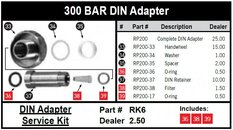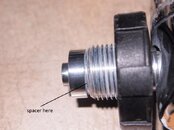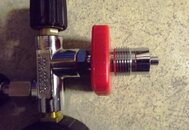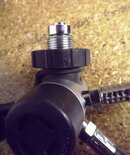Did some measurements and experiments and where (but not why) the problem is. I took the Sea Air DIN kit off the regulator.
View attachment 197859
and inserted part 37 with o-ring 36 into the tank valve. It seemed to seat well. I then screwed in part 33 until it was as far in as it would go. At this point I could move part 37/36 about a millimeter in and out. Which incidentally coincided with some earlier measurements. I then took a suitable o-ring (about a 116 or so) and slide it on the part 37 before sliding part 33 over 37 and screwing it back into the valve. Snug as a bug in a rug. Next was to re-install 37/36/33 and the extraneous o-ring to the regulator and pressure test. Perfect!
So why is the brand new 300 BAR male DIN assembly a millimeter too short for the older 300 BAR female tank valve??? Easy enough to fix, now all I need is to find a brass spacer to fit where I have the extraneous o-ring. It isn't an airtight connection, just a mechanical spacer. My original 'fix' involved both an extra airtight seal and a mechanical spacer. This is so much cleaner and not in a place it can fall out and get lost. Just using the o-ring as the spacer would probably work, but that even makes me a little nervous.
View attachment 197869This is the ScubaPro universal kit. It is the one that sealed "as is", but it is marked to show where I added the spacer.







